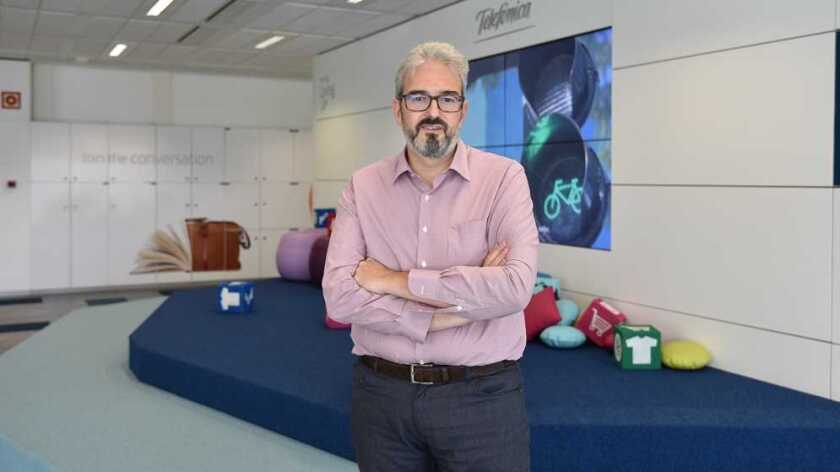November 2019 saw Telefónica announce a bold company-wide strategy that saw the telco spin off its businesses in Hispanoamérica, prioritise Spain, Brazil, the UK and Germany as its key markets, introduce a new operating model and create a consolidated infrastructure business called Telefónica Infra.
Part of this plan included the launch of Telefónica Tech, a newly created unit for the B2B segment focused on cybersecurity, IoT and big data, blockchain and cloud.
José Luis Núñez Díaz is Telefónica Tech’s global head of blockchain business and he and his team have been hard at work enhancing services across the business with this innovative new technology.
March 2021 saw the new unit partner with Fibocom Wireless, a wireless IoT solutions provider, and aitos.io, an IoT and blockchain start-up, to create joint solutions combining IoT and blockchain technologies.
Speaking on this collaboration and what it means for the market, Díaz says: “Thanks to this collaboration with Fibocom and aitos.io, we enable devices to sign and send data directly to the blockchain. So we are exponentially multiplying the capillarity of blockchain networks, as long as any device can interact in a more secure and reliable way and we can build trusted networks of devices that collect and exchange information from the processes they are monitoring in real time.”
Through this technology, and that the devices are trusted, Díaz says this information is immutable strengthening the business relationships between companies and avoids complex processes of validation, verification and dispute resolution.
Whenever we speak about blockchain technology, on the mainstream side of things we think of cryptocurrencies, namely Bitcoin. In the telecoms arena we think of things like payment settlement, verification and security, but typically deployed in cloud environments. But what about its application across other areas of network infrastructure?
“Any asset can be tokenised and tracked by a blockchain ecosystem,” says Díaz. “We can think in simple applications like adding to the blockchain the record of operations and inspections done to cables or towers.”
One specific example he cites is using blockchain to record third-party cable maintenance to note that scheduled tasks are done effectively, who will execute them and when – all with the reassurance of irrefutable data to settle any hesitation.
In the telco space, blockchain has been subject to a number of proofs of concept over the last few years, primarily in the areas of roaming, trading of tariffs, fraud management and 5G deployment, etc. Despite these advances, trust truly is the biggest benefit of this technology as we move more rapidly towards the next digital revolution, with broadband connectivity and telco networks at the very heart of it.
“We don’t say security, we don’t say reliability, we don’t say privacy – we say TRUST,” explains Díaz. “This implies that nobody has to validate, certificate or audit what’s happening in the network, the network itself will do it through a blockchain layer. Building this layer of trust is the challenge that telcos have for these next months.”
According to Díaz, the next stage of development for telcos is understanding how to monetise it, because although they can enjoy all these trust-based benefits “does it create new value for the telcos?” Telefónica believes it does.
With the telco blockchain roadmap still to be figured out, it then raises the question of when we can realistically expect to see widespread adoption at an industry level.
“Massive adoption from telcos will have more to do with their needs as large companies than with developing a value proposition around blockchain,” Díaz says.
“The next five years will be key for consistent deployments using blockchain, not only in telcos, but also among companies of a certain size or with a certain innovative profile.”
Slowly over time he expects to see companies starting to manage their supply chain through blockchain solutions or tokenising some of their physical assets in order to trade them in secondary markets.
“The rest will only translate into efficiency gains for the companies deploying these cases, but this movement will demonstrate that blockchain capabilities will be efficiently deployed over digital ecosystems,” he adds.
Part of what makes blockchain an attractive solution is that it is entirely software-based, so no expensive or cumbersome hardware is needed and it can be deployed quickly with minimal upkeep.
“Unlike other technologies, blockchain is just software. No regulatory restrictions apply to blockchain itself beyond the one that already applies to the use cases to be developed,” echoes Díaz.
“Nor do we have to deal with the complexity of network deployments or specific hardware. We just need to deploy some nodes in the cloud and properly manage to connect with other IT solutions.”
It’s this type of simplicity that drove Telefónica to develop its TrustOS blockchain offering, which includes a set of network modules and JSON APIs that reduce the time to market to add blockchain to existing solutions across industries.
Due to the inherently secure nature of blockchain, the business value it offers companies, according to Díaz, can be built on the three elements of the technology; “The immutability of the information that is managed in a blockchain network, its traceability and transparency of all operations – always maintaining the user’s privacy – and absolute and certain control over the information that is placed on the blockchain.”
Such use cases include the issue of certifications and verifying credentials; traceability to verify steps have completed in a process or the successive states through which an asset has passed; immutability in logistics and supply chain – namely smart contracts; and lastly transferable value through tokenization, a reference to the NFT boom we’re seeing at the moment.
For its part, Telefónica’s TrustOS product, its complete blockchain solution, “includes powerful modules that packed all blockchain capabilities that users need to build these four families of use cases very easily without them needing to know anything about blockchain”.
Despite all the potential opportunities blockchain holds, we cannot ignore the importance of other emerging technologies in the space and the role they play in enhancing blockchain in our industry. Having established the advantages of immutable information managed in the blockchain, Díaz reminds us that said information needs to be verified first.
“Before becoming immutable, we must assure that that information is true and reliable. So, we can add mechanisms to digitally gather the information, verify it and then feed the chain. The most obvious technology to do that is IoT,” he explains.
One of the best ways to avoid things like IoT devices being tampered with, for example, is through the use of artificial intelligence – to “analyse behaviours about how IoT devices are sending information [which] brings us an additional confidence about the data we gather” or to use it to gather information to certify the veracity of some claims.
“If we understand that the blockchain network is the hub where reliable information is flowing,” says Díaz. “The more information flows, the more need to trust it, and blockchain provides that additional trust.”
Over the next 10 years or so Díaz predicts “an explosion of blockchain cases with companies deploying their own networks, often on cloud infrastructure”.
Interestingly, he thinks that for the sake of efficiency, a convergence will occur with groups of companies created with a common goal, which is to operate the converged network – creating along with it a new type of operator.
“In this situation, a new role will emerge, the blockchain network operator, which not many companies are able to perform,” he says.
On one hand, he says that hyperscalers will deliver the facilities to deploy these blockchain networks into their infrastructure; but on the other, they won’t be able to offer the “collegiate or syndicated solutions to solve this problem”. At the same time, existing blockchain consortiums and companies will evolve to fulfil that exact blockchain network operator role.
But Díaz believes that many of the requirements of said blockchain network operator exist within traditional telcos already.
“There is already a profile of a company that knows how to operate networks and commit to certain service levels with its customers,” he says.
“This is what telco operators know how to do and have been doing, so we believe that in the medium term they can and should play this new role and get a significant quote in this industry.”
Having launched TrustOS in 2020, Telefónica’s goal was to simplify blockchain for companies, making it easier to enjoy the benefits of the technology by connecting their existing solutions with its platform.
“We aim to grow during 2021 to become a reference in Telefónica footprint and track millions of assets across industries,” says Díaz.
His team are also working with several partners in the deployment of purpose-specific networks and interoperability between them is integral. One such infrastructure project includes the European Blockchain Services Infrastructure (EBSI), led by the European Commission.
The project is developing a peer-to-peer network of interconnected nodes running a blockchain-based services infrastructure and is expected to complete at some point this year.
For Telefónica’s part, Díaz says, “we will evolve TrustOS to enable users to easily connect with EBSI services.”
So, whether blockchain firms are to be the new blockchain operators or if telcos will come together to meet the need, Díaz and the team over at Telefónica will be leading the charge, with trust at the core.









